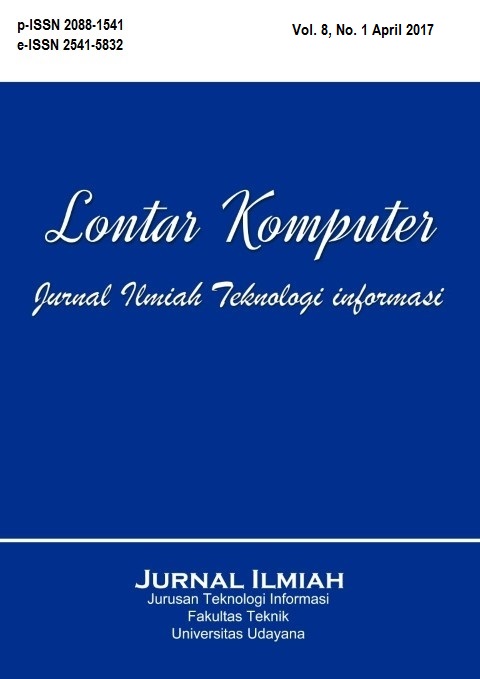Prediction of Wave-induced Liquefaction using Artificial Neural Network and Wide Genetic Algorithm
Abstract
The hassle of analytical and numerical solution for liquefaction modeling, repetitive laboratory testing and expensive field observations, have opened opportunities to develop simple, practical, inexpensive and valid prediction of wave-induced liquefaction. In this study, Artificial Neural Network (ANN) regression modeling is used to predict the depth of liquefaction. Despite of using Back Propagation (BP) to train ANN, a modified Genetic Algorithm (called as Wide GA, WGA) is used as ANN training method to improve ANN prediction accuracy and to overcome BP weaknesses such as premature convergence and local optimum. WGA also aim to avoid conventional GA weaknesses such as low population diversity and narrow search coverage. Key WGA operations are Wide Tournament Selection, Multi-Parent BLX-? Crossover, Aggregate Mate Pool Mutation and Direct Fresh Mutation-Crossover. ANN prediction accuracy measured by Median APE (MdAPE). Global optimum solution of WGA is best ANN connections weights configuration with smallest MdAPE.
Downloads
References
[2] C. C. Liao, Y. G. Z. Lin and D.-S. Jeng, "Coupling model for waves propagating over a porous seabed," Theoretical and Applied Mechanics Letters, vol. 5, no. 2, 2015.
[3] F. Gorunescu, Data Mining: Concepts, Models and Techniques, Berlin: Springer-Verlag, 2010.
[4] J. Han and M. Kamber, Data Mining: Concepts and Techniques, Elsevier, 2006.
[5] J. H. Holland, "Genetic algorithms," 2 10 2012. [Online]. Available: http://www.scholarpedia.org/article/Genetic_algorithms.
[6] S. C. Tuna and S. Altun, "Modern Approaches in Soil Liquefaction Analysis," in 6th International Conference on Earthquake Geotechnical Engineering, 2015.
[7] K. Ishihara and A. Yamazaki, "Analysis of wave-induced liquefaction in seabed deposits of sand," Japanese Society of Soil Mechanics and Foundation Engineering, vol. 24, no. 3, pp. 85-100, 1984.
[8] B. M. Sumer, Liquefaction Around Marine Structures, 2014.
[9] J. Jaky, "The coefficient of earth pressure at rest," Journal of the Society of Hungarian Architects and Engineers, vol. 78, no. 22, pp. 355-358, 1944.
[10] M. V. Shcherbakov, A. Brebels, N. L. Shcherbakova, A. P. Tyukov, T. A. Janovsky and V. A. Kamaev, "A survey of forecast error measures," World Applied Sciences Journal, no. 24, pp. 171-176, 2013.
[11] E. Ogasawara, L. C. Martinez, D. D. Oliveira, G. Zimbrão, G. L. Pappa and M. Mattoso, "Adaptive normalization: A novel data normalization approach for non-stationary time series," International Joint Conference on Neural Networks, pp. 1-8, 2010.
[12] V. Nair and G. E. Hinton, "Rectified Linear Units Improve Restricted Boltzmann Machines," Proceedings of the 27th International Conference on Machine Learning (ICML-10), pp. 807-814, 2010.
[13] P. U. Diehl, D. Neil, J. Binas, M. Cook, S.-C. Liu and M. Pfeiffer, "Fast-classifying, high-accuracy spiking deep networks through weight and threshold balancing," International Joint Conference on Neural Networks, pp. 1-8, 2015.
[14] M. Lozano, F. Herrera and J. Ramón, "Replacement strategies to preserve useful diversity in steady-state genetic algorithms," Information Sciences, vol. 178, no. 23, 2008.
[15] D. Gupta and S. Ghafir, "An overview of methods maintaining diversity in genetic algorithms," International journal of emerging technology and advanced engineering, pp. 56-60, 2012.
[16] S. Picek, D. Jakobovic and M. Golub, "On the recombination operator in the real-coded genetic algorithms," Evolutionary Computation (CEC), 2013.
[17] S. Tsutsui and A. Ghosh, "A study on the effect of multi-parent recombination in real coded genetic algorithms," Evolutionary Computation Proceedings, 1998. IEEE World Congress on Computational Intelligence., The 1998 IEEE International Conference, 1998.
[18] A. Ariyarit and M. Kanazaki, "Multi-modal distribution crossover method based on two crossing segments bounded by selected parents applied to multi-objective design optimization," Journal of Mechanical Science and Technology, 2015.
[19] Y. Yoon and Y.-H. Kim, The roles of crossover and mutation in real-coded genetic algorithms, INTECH Open Access Publisher, 2012.
[20] Y. Zhang, X. Gao and S. Katayama, "Weld appearance prediction with BP neural network improved by genetic algorithm during disk laser welding," Journal of Manufacturing Systems, 2015.
[21] A. Jarndal, "Combined genetic algorithm and neural network technique for transistor modeling," ommunications, Signal Processing, and their Applications (ICCSPA), 2015 International Conference, 2015.
[22] M. B. Takahashi, R. J. Celso and E. G. F. Núñez, "Optimization of artificial neural network by genetic algorithm for describing viral production from uniform design data," Process Biochemistry, 2015.
Keywords
The Authors submitting a manuscript do so on the understanding that if accepted for publication, the copyright of the article shall be assigned to Jurnal Lontar Komputer as the publisher of the journal. Copyright encompasses exclusive rights to reproduce and deliver the article in all forms and media, as well as translations. The reproduction of any part of this journal (printed or online) will be allowed only with written permission from Jurnal Lontar Komputer. The Editorial Board of Jurnal Lontar Komputer makes every effort to ensure that no wrong or misleading data, opinions, or statements be published in the journal.
 This work is licensed under a Creative Commons Attribution 4.0 International License.
This work is licensed under a Creative Commons Attribution 4.0 International License.























